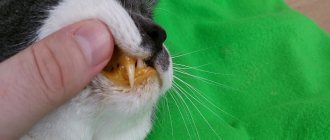12595Administration
1
Fungal infections in cats are quite common diseases. Spores of pathogenic fungi are carried by air and, if the animal’s immunity weakens, quickly lead to the development of disease. It is very important for owners to know the symptoms and treatment of fungus in cats, since only if therapy is started on time, they can eliminate the problem quickly and prevent serious harm to the pet’s health.
Cats always have fungal spores on their skin, and even a pet that does not leave the apartment has them. Being present in the animal normally, spores do not develop and do not lead to problems. If there is a violation of the skin condition, then, in addition to treating the lesion, therapy is also required to increase immunity . When a cat lives in the house, the budget must include an item for the cost of its treatment if necessary.
What can lead to the formation of fungus
If we consider the picture as a whole, we can say that the appearance of nail fungus in cats (and not only it) occurs when the pet has physical contact with other representatives of its species.
In this case, even those cats that lead a domestic lifestyle are not insured, as they can pick up pathogens from the outdoor shoes and clothes of their owners.
This is especially true in rainy weather or in a house where there is a constant humid environment. In addition, you should be wary of minor injuries, diaper rash, etc.
The following factors can lead to the appearance of fungus:
- A young and fragile body;
- The period of lambing in a cat, when the body’s defense systems weaken;
- Decreased immunity due to the activity of a dangerous virus;
- Poor feeding;
- Carrying out immunosuppressive therapy;
- The influence of other serious diseases such as diabetes.
In some cases, diseases of this type may be asymptomatic, so they can only be detected after the hosts themselves have become infected. Very often children become the first carriers, as they most often play with pets.
Methods for diagnosing pathology
Effective methods for diagnosing the disease:
- Luminescent method. Several hairs from the lesion site are illuminated under a Wood's lamp. The affected hairs change their color to blue. This method is used only in combination with other diagnostic methods.
- Microscopic examination. The crusts that form during the process are examined by a specialist using optical equipment. Infection with a fungus is indicated by white fragments in the structure of keratinized skin.
- Mycological method. It is one of the most effective, as it makes it possible to identify a specific pathogen. First, scraping is performed from the lesion. Then the epithelium particles are placed in a nutrient medium and grown. After this, you can determine the type of fungus.
- Stool analysis. Necessary for identifying a parasitic infection, since helminthic infestations often give similar clinical signs.
Additionally, blood is drawn from the pet to determine the condition of the body. An increased level of leukocytes indicates an inflammatory process.
Manifestation of the disease
Once pathogenic microbes have reached the skin surface, they immediately begin to harm the health of the cat (by releasing toxic toxins and enzymes).
Over time, this can lead to the death of the epidermis from the upper skin and the development of inflammatory processes.If the owner notices that the first symptoms of fungus have appeared in the cat, then it urgently needs to be shown to an experienced professional.
After all, without proper care, the fungus will penetrate deeper into the pet’s body, damaging the fur structure and hair follicles.
What signs can be used to determine the presence of harmful parasites? First of all this:
Seizures in cats - main causes, symptoms, first aid, treatment and choice of drugs (110 photos)Polycystic kidney disease in cats - causes, diagnosis and symptoms of the disease. Treatment options and prevention of kidney disease (95 photos)
Tartar in cats - signs of the disease and methods of fully treating tartar (125 photos + video)
- Loss of damaged pieces of fur;
- The presence of empty bald spots on the cat with clear boundaries in the head, ear area, and also on the paws;
- Restless behavior (the animal runs from corner to corner, itches and often rubs against objects);
- Scabies;
- Bad smell;
- The presence of a strange, pinpoint plaque in the ears;
- Formation of tubercles on the skin surface;
- Frequent sneezing;
- Bloody runny nose.
If the situation is neglected, the initial symptoms can develop into a severe form of the disease, which will lead to anemia, pneumonia, and complications in the gastrointestinal tract.
If the cat is still young or weakened (for example, due to lack of food), this can be fatal.
Treatment
Advanced disease entails hearing loss, up to complete hearing loss, and brain damage. The earlier treatment is started, the higher the chance of a favorable outcome. Therapy consists of the use of antifungal or fungicidal drugs containing active ingredients:
- terbinafine and thiabendazole for external use;
- griseofulvin for oral administration;
- flucytosine and amphotericin B - in the form of infusions for severe forms of the disease.
Drops and ointments are prescribed for placement in the ear. Treatment is selected only by a veterinarian based on the results of laboratory tests.
Measures to prevent ear fungus:
- strengthening the immune system;
- balanced diet;
- moderate bathing – up to 5-6 times a year;
- timely treatment of chronic diseases.
It is recommended to have your pet regularly examined by a veterinarian so as not to miss the onset of the disease.
Types of infections
If a person suspects that his pet has picked up an infection somewhere, but is not completely sure, it is worth looking into the global web and looking for photographs of fungus in cats.
There you will also find information on various types of fungal infections:
- Aspergillosis;
- Ringworm;
- Cryptococcosis;
- Malassezia;
- Candidiasis and others.
Prevention measures and vaccination
Vaccines against trichophytosis are not effective to date. They are used less and less. The most popular vaccine is Vakderm, which is used to prevent viral and fungal infections. Injections are administered 2 times with an interval of 2–3 weeks. Prevention rules:
- Do not include low-quality food in your pet’s diet.
- Avoid cat contact with street animals.
- Regularly carry out wet cleaning using chlorine.
- Keep your cat's litter box clean.
- Do not let the animal outside unattended.
- Wash your paws after a walk.
- Make sure that the animal does not play with shoes.
- Give your cat vitamin complexes, especially if the body is weakened.
- Deworm your pet once every 6–12 months using special veterinary complexes.
Castrated and sterilized animals are at risk of infection, so you need to especially carefully monitor the condition of the body of these pets, feed them only appropriate food, and protect them from hypothermia.
Photo of fungus in cats
Ringworm in cats - main signs, symptoms, prevention and treatment of ringworm in cats (105 photos)Pancreatitis in cats: first symptoms, nutritional nuances and treatment options (125 photos and videos)
Subcutaneous mites in cats - first symptoms, treatment options and real photos of examples of parasite damage (110 photos + video)
Read here Hyperparathyroidism in cats: how to treat and how to identify the first symptoms. Tips and recommendations from veterinarians on how to cure hyperparathyroidism (110 photos and videos)
Help the site, share with friends 
Who can get thrush?
Thrush can affect men, women, children and even animals. Typically, vaginal candidiasis affects women, and less often, due to anatomical features, men. In children, thrush can be localized in the oral cavity.
In children (most often in newborns) it is called candidomycosis stomatitis. Outwardly it looks like white dots on the oral mucosa. It can appear in children who frequently spit up, and also if the skin around the nipples of a nursing mother is affected by cutaneous candidiasis.
Vaginal candidiasis is a fairly common disease in women. A huge number of women take oral contraceptives (birth control pills), with prolonged use of which any slightest malfunction in the body’s functioning leads to a weakened immune system and, as a result, to the development of thrush.
It is reassuring that during pregnancy, candidiasis does not pose a threat to the health of the unborn child, except in cases of untreated thrush. During childbirth, the mother can infect the baby, and the newborn will suffer from candidomycosis stomatitis.
Important! Under no circumstances should pregnant women self-medicate with candidiasis, since many antifungal drugs are contraindicated for pregnant women.
Candidiasis is less common in men than in women. When Candida affects the head of the penis, balanitis develops; when the foreskin is affected, balanoposthitis develops. Painful rashes may appear on the penis, and the affected areas become swollen. The discharge, just like in women, is cheesy in nature, but has an unpleasant odor.
Our smaller brothers are susceptible to attacks by Candida fungi no less than humans.
In cats, the most common sites of infection are the ears, mouth and foreskin. The presence of candidiasis is indicated by poorly healing ulcers on the skin surrounded by a reddish border, covered with a flaky whitish coating. The fur falls out at the locations of the ulcers.
In dogs, the hair in the affected area becomes dull and falls out, bald spots form, the skin changes pigmentation - it darkens, and a yeasty odor emanating from the skin may be felt. The animal is restless, constantly scratching its irritated skin, sometimes even gnawing at the affected areas of the skin.
Why do wounds occur?
Infectious diseases
Most often, the formation of ulcers and crusts on the nose is promoted by ailments, such as:
Return to contents
Calicivirus
It is caused by the Feline calicivirus virus. Infection occurs through contact with a sick animal through saliva, nasal moisture, tears, or when a healthy animal uses bowls and a tray of an infected animal. A cat can also inhale the virus. Manifestation:
- the appearance of wounds on the mucous membranes of the nose and mouth;
- refusal to eat;
- temperature increase;
- dyspnea;
- conjunctivitis;
- lameness due to inflammation of the joints.
Return to contents
Fungal infections
The causative agents are the fungi cryptococcosis, actinomycosis, and Candida. Routes of infection include contact with a sick animal, long-term use of antibiotics, and decreased immunity. Cats that come into contact with soil and birds can also become infected. The fungus can affect not only mucous membranes, but also appear on the pads of the paws, between the toes, and spread to the stomach and genitals. Symptoms:
- bloody discharge from the nose that forms crusts;
- cough, sneezing;
- temperature increase;
- the appearance of a whitish coating or scales on the respiratory system or in the mouth;
- general deterioration of condition.
Return to contents
Bordetellosis
The disease is caused by Bordetella bacteria, and the disease itself can be transmitted from animals to humans. Cats get sick through contact with saliva, moisture from the nose, sneezing of a bacteria carrier, and also by eating food from the bowl of a sick animal. Signs:
- discharge from the eyes and nose, at the site of which cracks and sores appear;
- decreased appetite;
- hyperemia;
- difficulty breathing;
- cough;
- enlarged lymph nodes.
Return to contents
Allergic reaction
It occurs as a response of the cat’s immune system to an allergen. These include cleaning products, indoor mold, dust, and medications. The cause of an allergic reaction can be food additives if the owner treats the pet with smoked or canned foods that are not intended for animals. Symptoms:
- crack or wound on the lips, nose, bald patches near the ears;
- redness of the ears and skin;
- hair loss, bald patches;
- severe itching of the affected areas;
- worry and anxiety.
Causes of thrush
The main reason is decreased immunity and imbalance of microflora, which can occur as a result of:
- past or chronic infectious diseases;
- treatment with antibiotics, cytostatics and corticosteroids;
- dysbacteriosis;
- alcohol abuse;
- smoking;
- the body being in a state of hypovitaminosis or anemia;
- diseases of diabetes mellitus and other edocrine diseases accompanied by metabolic disorders;
- pregnancy and any changes in the hormonal balance of the body (taking contraceptives, menstrual irregularities);
- surgical interventions or mechanical and chemical injuries;
- wearing synthetic underwear that fits tightly to the body. (Thongs made from artificial fabrics are especially dangerous - a thin strip of fabric is an excellent bridge for the penetration of pathogenic intestinal bacteria into an unfamiliar habitat; synthetics create a greenhouse effect that promotes the rapid development of microorganisms).
Candidiasis can be transmitted sexually. If the body's immune defense works perfectly, then infection is not necessary. But where have you seen a person with excellent immunity today? Residents of hot countries are more at risk of candidiasis - yeast fungi of the genus Candida thrive in a humid, warm environment.











